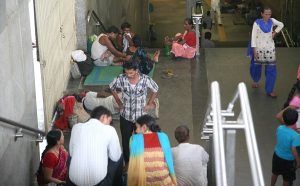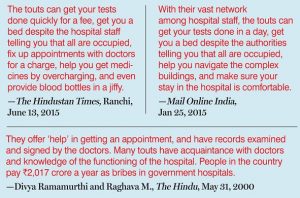It’s not the doctors but a burgeoning army of middlemen that public and private hospitals are pampering. An extract from the book The Ethical Doctor
The Medical Council of India warns doctors explicitly: ‘A physician shall not use touts or agents for procuring patients.’ Medicine has become a business, and one sure way this reality manifests is in the way the art is reduced to a commodity that must be sold. In the unregulated, unsupported environment that private doctors work in this country, attracting patients takes up a major part of their time and effort; the kind of time and effort that one hopes would otherwise be spent looking after patients and developing science. No surprise then that our doctors generally do very poorly in pushing new frontiers and the contribution of Indian private sector doctors to global scientific media literature is minuscule.
Touts constitute one of the most interesting aspects of health care in India. It may even sound funny if it did not have really serious consequences. You’ve got these helping hands all over the place. They act as middlemen and appear from nowhere, precisely when you need such help. They have contacts in high places. Depending on your need, they can arrange anything and everything. They will get you to the right doctor, the right laboratory and the right hospital, just when you are beginning to feel lost in a new city. In lieu, they will take a commission either from you or from the doctor or laboratory or hospital, depending on the services provided. For example, touts from villages will barge into doctors’ offices in towns and cities, declare to the doctor that they have ‘brought’ a patient, explain what they want the doctor to do, clarify how deep the patient’s pockets are, and finally agree on the commission with the doctor. Depending on how desperate the doctor is, the commission can be quite substantial.

This phenomenon is by no means specific to rural patients seeking help in big cities. In urban practice, it takes different forms and is rampant in both public and private sector hospitals. In the public sector, these touts are sometimes the channels whereby government doctors and officers earn extra money. In the private sector, they are employed by many doctors, laboratories and hospitals to attract patients. They prey upon the sick at a time when they are most vulnerable, masquerading as God’s angels. These are a thriving community unto themselves—the Indian medical touts.
Touts constitute one of the most interesting aspects of health care in India. It may even sound funny if it did not have really serious consequences. You’ve got these helping hands all over the place. They act as middlemen and appear from nowhere, precisely when you need such help.
In a very poor country like ours, there is no shortage of people who will do anything for you for any wage. For a monthly salary in the range of Rs 10,000 to Rs 20,000, you can hire any number of ‘marketing executives’ or ‘secretaries’ or ‘personal assistants’ you like. In a market where one can make tens of thousands of rupees from just one patient, many hospitals and nursing home owners know that such employees finance their own employment and it pays back to have as many of them around as possible. The job is simple—they have to ensure a constant stream of patients. This means interacting with local doctors and establishing deals.
 This also means tying up with quacks and RMPs in villages…. There is a third method of getting patients to a clinic or a hospital—via a tout who preys upon helpless patients in government hospitals, at bus stands, railway stations, or anywhere else. Obviously when one gets better at this job, one won’t work for Rs 10,000 a month, and voila! A freelance tout is born.
This also means tying up with quacks and RMPs in villages…. There is a third method of getting patients to a clinic or a hospital—via a tout who preys upon helpless patients in government hospitals, at bus stands, railway stations, or anywhere else. Obviously when one gets better at this job, one won’t work for Rs 10,000 a month, and voila! A freelance tout is born.
The Indian health care system is riddled with these touts. They are sometimes the staff working in hospitals, looking to make some extra money. It could be the receptionist, the billing clerk, the ward boy, the liftman, the toilet cleaner, and even the telephone operator. More often, they are professional touts working for doctors and diagnostic facilities but pretending to be a helping hand around sick patients and their worried relatives. One does not have to be a genius mathematician to figure out that each of these touts needs to be successful just a few times in a year for the employers to recover the wages for the whole year.
Touts know the system. Babus in government offices will not even entertain you because what they can’t ask for openly, these touts will do for them. This applies to doctors too. These touts keep our officers and doctors safe from the dirty details.
The more talented and adventurous amongst these develop significant networks within the system and of course do much better. They know how patients turning up at a hospital can be deflected to their patrons. If a certain Dr Singh, in a private hospital in New Delhi, is wondering why nobody ever comes to his clinics, he only needs to send a decoy disguised as a patient to the receptionist in the hospital or to any others who have taken it upon themselves to guide patients in finding somebody whom they can work with. If the hospital reception never puts any patient through to the telephone line in Dr Singh’s room, it is possible that the receptionist has been asked to divert all calls to a different number, or it may even be that the telephone ringer is turned off. If you think about it, these people are more ingenious than some of the doctors who occupy these rooms. What a waste of talent though! The management in both private and government institutions knows about these touts who operate in their facilities, but they are helpless. It does not really bother the private hospital which of their consultants gets the patients, as long as they are being seen in the hospital. In fact, if they nurture and support a consultant with an effective (marketing) team, it is more than likely that this person will also pull in business for the hospital from its competitors. Given a choice between ethical doctors who, in the eyes of the management, are lazy sinecures, simply waiting for patients to show up so they can give their professional advice, and doctors who are sufficiently motivated to walk an extra mile to get patients to the hospital and encourage them to get admitted and have operations (sometimes unnecessary), every hospital manager in India knows which one to choose. Health care is a business, and it has to be run like one.
 It probably started with owners of nursing homes and hospitals who cannot survive without a regular stream of patients. Their outgoings are fixed and the business will lose money if each bed does not have a patient in it at any given point of time. (Hospitals use a technical term called bed occupancy rates to express this.) Under these circumstances, it pays to have as large a pool as possible of marketing executives (that is, touts) to tap patients from as wide an area as possible….
It probably started with owners of nursing homes and hospitals who cannot survive without a regular stream of patients. Their outgoings are fixed and the business will lose money if each bed does not have a patient in it at any given point of time. (Hospitals use a technical term called bed occupancy rates to express this.) Under these circumstances, it pays to have as large a pool as possible of marketing executives (that is, touts) to tap patients from as wide an area as possible….
Touts know the system. Babus in government offices will not even entertain you because what they can’t ask for openly, these touts will do for them. This applies to doctors too. These touts keep our officers and doctors safe from the dirty details. They put themselves in the firing line to protect those sitting in big offices and lavish chambers…. They help our systems function smoothly despite all the underlying imperfections. The babus who are actually employed to do the job are able to enjoy morning tea in office, read newspapers, and also simultaneously increase their income, while a parallel army of touts does all the work. Doctors are able to concentrate on patients while touts take care of the business of attracting business. Such innovative Indian solutions for Indian problems!
Lead picture: Hospitals devise any number of means to attract richie-rich “customers”. Photo: www.miotinternational.com


